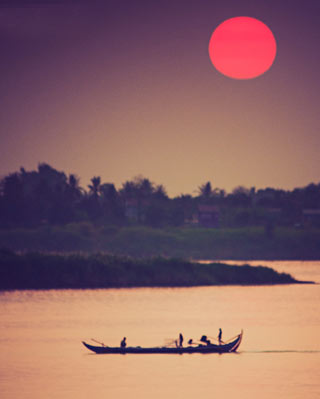Best Time to take a Mekong River Cruise to Vietnam and Cambodia
Despite being connected by the Mekong River, Vietnam and Cambodia have quite diverse topographies due to their respective terrains. While the former is far more varied due to the country's elongated and narrow shape, spanning approximately 1,650 kilometers from north to south, with central highlands and mountainous regions in the far north and northwest, the latter is characterized by mostly low, flat plains with mountains in the southwest and north.

As Vietnam and Cambodia are all-year-round destinations, there is a lot to discover and enjoy, including cultures, nature, cuisines, and adventure, depending on when you arrange your journey. In this post, we will suggest the best time to visit both countries that will help you make the most of your trip in Cambodia and Vietnam.
1. Vietnam Weather
Thanks to its geographical diversity, the south part of Vietnam experiences distinct seasons compared to the north. The northern area, which contains popular tourist attractions such as Hanoi, the UNESCO World Heritage Site of Halong Bay, and the highland town of Sapa, has four seasons: spring, summer, autumn, and winter.

Northern Vietnam's winter season (December to February) has an average temperature of roughly 20°C (68°F); however, it can drop as low as 10°C (50°F). Summertime in the north (May to August) is hot and humid, with temperatures hovering around 32°C (70°F) and significant rains lasting until mid-October.
Spring (March to April) and fall (September to November) are both good periods to visit Northern Vietnam since the temperatures are gentler and the days are often bright and sunny, making them excellent for outdoor activities. Typhoons can hit Vietnam's central coast during the rainy season, which lasts from August to November.

In the south, which includes Vietnam's most populous city, Ho Chi Minh City, as well as the Mekong Delta, there are primarily two seasons: the rainy season (May to October) and the dry season (November to April). Meanwhile, in the country's central region, which includes the historic and cultural cities of Hoi An and Hue, the summer dry season lasts from February to August.
2. When to visit Vietnam
The ideal time to travel in Vietnam is from November to April, when the country encounters the least amount of rainfall. However, because the country's topography is so diverse, you need to plan your vacation during particular months to visit the various locations.
March to April, and September to November
Spring and autumn are the perfect seasons to visit Sapa, Hanoi, and Halong Bay in the north since the climate is typically nice, the temperatures are mild, and the rainfall is small.

July to August
When you visit the coastal cities of Hue and Hoi An, you should avoid the typhoon season, which ends in February. Warmer temperatures and sunshine will persist from February to August, but if you want warmer days, July and August are your best options.
December to February
While South Vietnam receives warm, comfortable weather throughout the year, the early part of the dry season is substantially cooler, making travel much more enjoyable. While the rainy season might cause flooding, it normally occurs in brief spurts and does not disrupt travel. In fact, this is the perfect time to take photos of the Mekong Delta's rice fields, which have become a vivid green.

3. Cambodia Weather
Cambodia, like South Vietnam, has two distinct seasons determined by its tropical monsoon weather: the rainy season lasting between mid-May and early October, with the effect of the southwest monsoon winds and temperatures averaging 27°C (80.6°F), and the dry season from late October to early May, with light northeast monsoon winds and temperatures ranging from 26°C (78°F) to 38°C (100°F).

Rainy season: mid-May to early October
During the wet season, the massive volume of water in the Mekong backs up into the Tonle River, which links to Tonle Sap Lake, growing its surface size from a dry-season low of 1,200 square miles (3,100 square kilometers) to a rainy-season high of more than 3,000 square miles (7,800 square kilometers). Travelers sailing during the high water season may explore floating communities on Tonle Lap Lake and the Prek Toal Bird Reserve.
Dry season: late October to early May
As the Mekong's water level decreases during the dry season, the process reverses: water drains from the Tonle Sap back into the Mekong, changing the direction of its flow, a naturally occurring phenomenon known as the 'flood pulse' system. During this time, the Tonle Sap Lake is unreachable from the Mekong via the Tonle River, preventing river ships from reaching there. That being said, it is a fantastic opportunity to explore a calmer side of local life along the Mekong.

4. When to visit Cambodia
June to August
For cultural vultures, the 'green season' is the best time to visit Cambodia and Angkor Wat, the largest religious structure in the world located in Siem Reap, since all of the huge tour groups have left, and you will have the UNESCO-listed temples to yourself. After the daily shower, the roads are less dusty, and the religious sites glisten and shine. The landscape is more attractive, with lush rice paddies, overflowing moats, and 'barays' around temples. When the conditions are just right, beautiful sunsets may be expected.

Mid-August to November
The wet season reduces visitor crowds, making the Mekong Delta much quieter. This is ideal for nature lovers to enjoy the verdant greenery of the flooded mangrove forests, ponds, and waterfalls, thanks to the Tonle Sap's abundance of water at its peak level, which increases its area by sixfold and brings back fish and bird migration and a rich ecosystem. It's also an excellent time to see the lake's floating villages and marketplaces on boat tours.
December to mid-August
Birdwatching is not limited to the wet season; during the dry season, the Prek Toal Sanctuary's large trees support the largest remaining flocks of ibises, pelicans, and storks in mainland Southeast Asia, all of which are threatened by egg and chick collection.
During this season, you can expect a crystal-clear blue sky, stunning green landscapes, and lower humidity levels. It's great for outdoor activities like biking, hiking, and kayaking. A Mekong River cruise trip provides a slice of local culture and rural village life by listening to local music performances, sampling tropical fruit, or experiencing the beautiful flower season (late January to March).
-ori.jpg)
Please note that this guide is just for reference about the weather in Vietnam and Cambodia. Climate conditions can change constantly without prior notice. When you have a specific departure date, you can check with your travel consultant for detailed information about the weather, schedules, routes, etc. If you’re considering a Mekong River cruise vacation, feel free to contact our cruise experts for the best deals and information.
















